WIE Orientation 2015 Shows Female Engineering Freshmen the Ropes
September 9, 2015
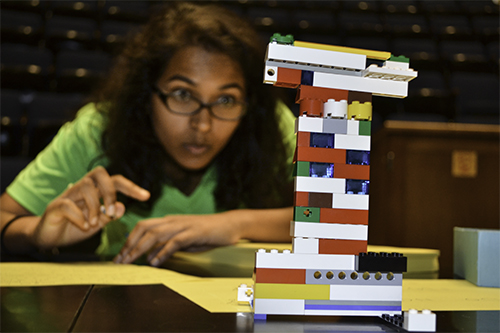
An Engineering freshman competes in a Lego team-building activity during WIE Orientation.
To get a head start on their first year in Engineering at Illinois, 257 young women attended the 2015 Women in Engineering (WIE) Orientation on August 18–19, 2015. One perk of participating? Getting to avoid the traffic jam that is move-in day by moving in early. But more importantly, these freshmen got a head start on community building and networking with peers, especially in their engineering disciplines. Other WIE Orientation goals were to introduce the girls to key folks in their departments, acquaint them with campus, plus provide practical tips to help them be successful students.
With the new school year came a new name: WIE Orientation. “The Legacy of WIE Camp still lives,” explains WIE Assistant Director Angie Wolters. “But sometimes freshmen were confused by the fact that we called it camp; instead, it is them coming early and getting oriented to campus.”
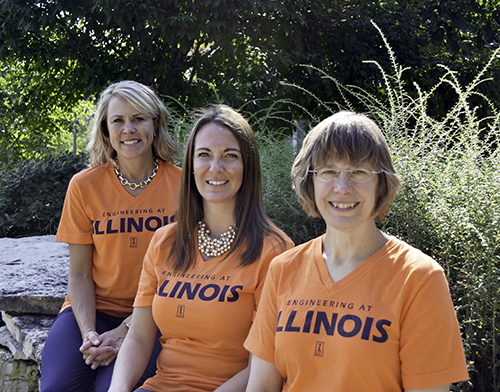
Left to right: WIE Assistant Director Angie Wolters, WIE Administrative Assistant Robin McDaniel, WIE Director Sue Larson.
One of the Orientation’s main goals was to foster networking and create community, much of which, according to WIE Director, Sue Larson, would just happen naturally. “Among the girls, it happens by their interacting; I think that’s the best way to build friendships and networks is to do things together.”
However, some networking was planned into the schedule: “We do have opportunities for them to meet people in their departments,” Larson continues. “Their departmental advisors, their department professors, because we have a department lunch so all the girls will go to the department that houses their major and enjoy lunch with some of the key people in that department.”
Planners also worked hard at facilitating ways the freshmen could get to know other students within their discipline and other interest groups.
“Because we have such a large group,” Wolters explains, “we’ve been very targeted with ways to make that large group smaller.”
This involved ensuring that the 45 upperclassman mentors, nearly all of whom had been WIE camp participants or counselors before, were teamed up with freshmen in their own department. Girls also ate with others in their major—even in their dorms, and one dinner was organized by special interest groups.
“So we’re grouping them according to interest,” continues Wolters, “so they really get that chance to be a small group that spends a substantial amount of time together so they really can get to know each other.”
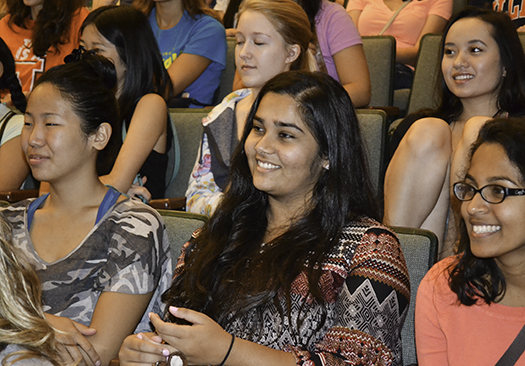
WIE Orientation participants enjoy the antics of Gretchen Adams and Don DeCoste during the chemistry demo.
Another way girls could get acquainted with students with like interests was back at their dorms. Some are part of Campus Housing’s Living & Learning Communities (LLCs), where students are housed based on special interest groups, for instance, WIMSE (Women in Math, Science, and Engineering), and Innovations (for students who want to create). Because WIE partnered with groups such as LLCs which also had early orientations, some students from these groups joined in for the Chemistry demo and various workshops.
After moving in on Tuesday, girls attended the evening's “welcome” event with its ice-breakers. One we’ll call “Trade-a-Bead; Make-a-Friend," where the girls did just that. Armed with packs of 40 beads, girls could trade with one another and end up with a colorful necklace.
Wednesday morning’s activities began in Loomis Lab with the girls seated in sections by engineering discipline so they could begin to get to know one another.
And to help freshmen begin adopting an engineering-involves-teamwork mindset, students did a Lego team-building exercise with an engineering slant: their titles mimicked personnel found in a company (a CEO or senior manager, a project manager, a materials supplier, and builders) and they had to create a design plan, a supply list, a process plan. The idea was to get them thinking—even talking—like engineers:
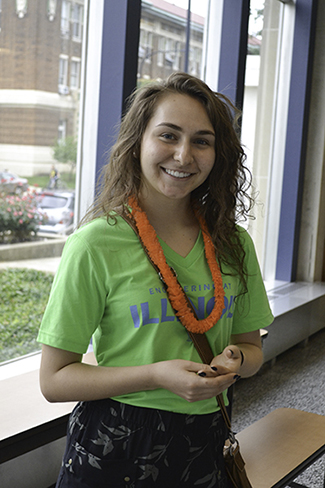
An engineering freshman, the project manager for her team, judging by her lei, waits to begin competing in the Lego team-building.
“So we’re even starting to get them accustomed to engineering lingo,” said Wolters.
At face value, it sounds pretty simple. Teams were to make exact replicas of a Lego structure. However, there was a catch. Each role was limited by certain constrictions.
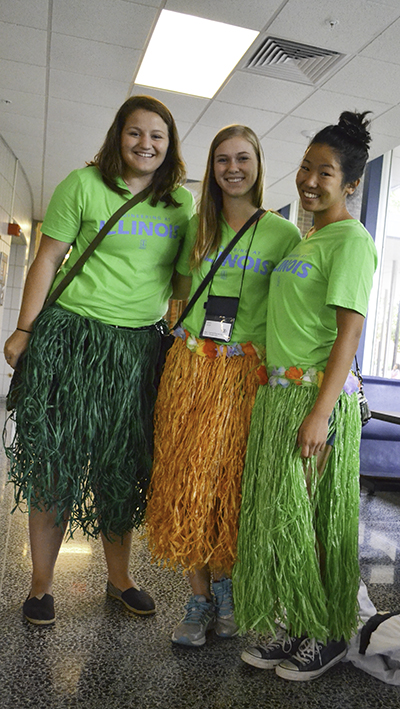 Engineering freshmen geared up to compete in the Lego team-building exercise.
Engineering freshmen geared up to compete in the Lego team-building exercise.For example, only the senior manager could view the structure. She was to then describe it to her team's project manager, who was to draw a sketch of it for the builders without actually seeing the structure. Only one person—the materials supplier—could view the Legos teams had to work with.
“So engineering communication,” explains Wolters.
“And teamwork,” adds Larson.
So, for a few hours on Wednesday morning, the normally staid, male-dominated Loomis Lab experienced organized pandemonium as a gaggle of girls—some arrayed in Hula skirts or leis—fiercely competed to make an accurate replica of the Lego structure as quickly as possible.
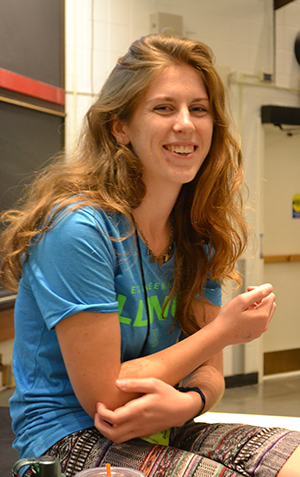
Student co-coordinator Emily Matijevich looks on as the WIE Orientation participants compete in the Lego activity.
One caveat: though the activity was borrowed from a corporate website, those corporate executives most likely hadn't donned hula skirts and leis. “We tried to make it more fun,” admits student coordinator Emily Matijevich, “because these are freshman undergraduate girls, not people in the corporate world.”
While fun, the Lego activity was still a learning opportunity. For example, undeclared Engineering freshman Hannah Nolton claims, “I learned the importance of detail and how hard it was to look at a sketch and make something out of it.”
Another undeclared student, Dowell Bryndice, reports, “I discovered that you should actually read the instructions before you begin, because I got ahead of myself and started making drawings and blah, blah, blah. But anyways, ‘Yeah, follow the instructions!’”
Another undeclared student learned something about problem solving: “I learned that there’s always different angles to look at problem solving. Like when we were making the 3D Heart. The answer isn’t always obvious.”
Following the Lego activity, came what Wolters calls “one of the best parts of WIE Orientation.” The girls adjourned to their respective academic departments to meet department personnel for lunch:
“They’re getting that chance to really feel comfortable, says Wolters, "and make those connections, so they know the multiple layers of resources they have”

Two teammates collaborate during the Lego team-building exercise.
She goes on to describe one resource: 3-tiered advising: at the college level is the WIE advisors; the second tier is faculty advisors; the third is departmental advisors.
“We’ve found a way for them to meet all of those tiers during orientation,” Wolters continues. “Then you feel good that they’ve met all these people and made those connections before they even start that first day of class.”
Students from every engineering department attended WIE Orientation, as well as a few NOT in engineering: LAS computer science and physics students. Says Wolters: “These students—they quite often consider changing their major and being part of the College. We want them to realize that, because they are studying an engineering discipline, that Women in Engineering is here to support them as well, and they’re going to be in the same classes as the other computer science and physics students.”
In addition to community building, another theme—“What we wish we had known when we were freshmen”—cropped up in many activities. Coordinators provided practical tips, ranging from Sue Larson’s traditional faux lecture, which kicked off Wednesday morning’s activities, through seven different workshops, which, according to Matijevich, addressed: “Things Lara and I wish we knew when we were incoming freshmen.” Workshops addressed note-taking tools, the bus system, things one should always carry in one’s bag, and how to have a successful career fair. They also introduced some cool technology available to Illinois students: Google account using Google drive, Box account, group messaging, plus the dining and bus system apps.
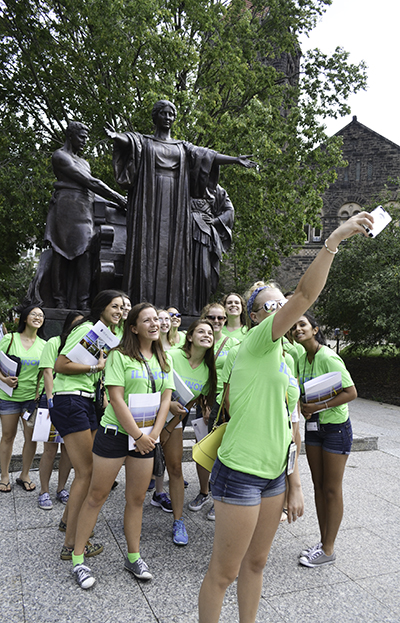
A group of WIE Orientation participants snap a selfie at Alma Mater—proof that they visited her during the scavenger hunt. Teams were required to post a photo of themselves at each point of interest on the Orientation's Facebook page.
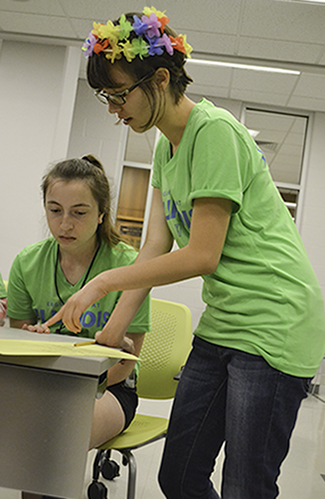
One team's project manager describes the Lego structure to a teammate.
Another important activity was the scavenger hunt. Designed to familiarize the girls with campus, it also gave mentors an opportunity to provide some "what-I-wish-I-had-known” hindsights. Again organized by departments, groups of girls strolled around campus following clues to points of interest like Alma Mater, the undergrad library, undergraduate advising in Engineering, and Grainger Bob. (Rumor has it, he will soon be lonely no more; he’s getting a long overdue female counterpart). During the tour, mentors encouraged freshmen to ask questions, plus shared advice on how to avoid pitfalls that had ensnared them as freshmen, liberally doling out advice about specific courses, professors, etc, having been down that path before.
“Throughout the summer,” explains Matijevich, “we asked mentors to make comments on some of the freshman year classes…tips like: ‘Make sure you go and pay attention during lecture; you get attendance points.’ ‘Make sure you get the practice test booklet; it was very helpful. They often pull exam questions right out of the booklet.’ Again, things Lara and I wish we had known freshman year.” In addition, each camper’s schedule had been printed off with these personalized comments on them. Plus, at the end of orientation, girls had an opportunity to find their classrooms ahead of the first day of classes, and stop by the bookstore to buy their books.
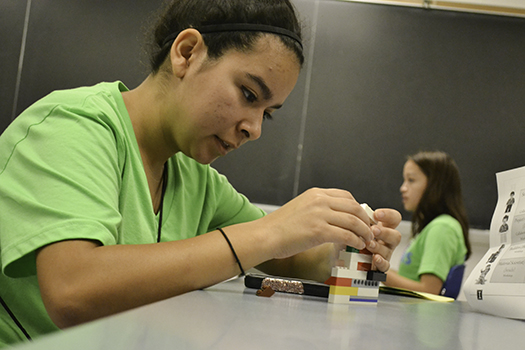
Salina Ortega builds her team's Lego structure.
One engineering freshman who didn’t necessarily need the campus tour was Computer Science major Salina Ortega, who had attended GAMES camps as a girl. How many?
“Five or six,” she admits. “I loved it!”
Ironically, the fact that Ortega’s parents are both electrical engineers didn’t necessarily influence her decision to become an engineer. If anything, it was more of a disincentive: “Actually it kind of deterred me from wanting to be an engineer for a while because I knew I didn’t want to do what they wanted me to do,” she reports. But GAMES camp saved the day. “So it wasn’t until I came to GAMES camp that I knew this is what I wanted to do.”
Did Ortega attend a CS GAMES camp? Two, actually. She rattles off the ones she attended: “I did mechanical engineering; I did robotics; I did CS; I did CS+ apps, which is different; I did structural; and there might be another one…but I think that might be it.”
Ortega, too, came for community building:
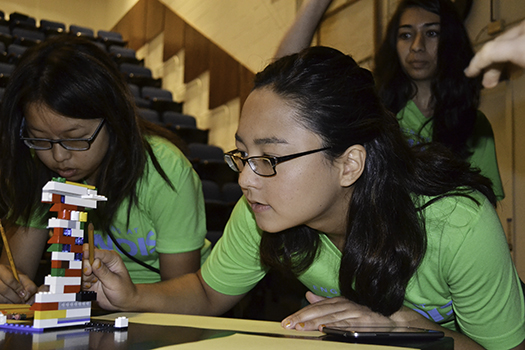
One team's senior manager studies the Lego strucuture so she can describe it to a teammate, who will draw a model.
“I just thought it sounded like a great opportunity to meet other women in engineering. They're kind of few and far between, so it’s nice to meet them.”
Many girls had also come early to get acquainted with other engineering students —just what WIE planners hoped to achieve. Megan Fox did, for example. The Civil and Environmental Engineering (CEE) freshman says:
“I came because I figured it was a good way to meet people, especially in my major. I figured I could make study groups later and have people I can connect with in my classes.”
So did Dakota Gonzales, also in CEE: “I figured it would be a good way to learn about my specific major and meet people from my major, so I could maybe see people in classes and everything.”
It wasn’t just freshmen who benefitted from WIE Orientation; according to Matijevich, the upperclassmen and coordinators did too. “While orientation is about the freshmen, I know the mentors and the coordinators, we’re gaining teaching skills, leadership skills. And for someone like me, I would love to teach someday. I’m learning how to explain things to freshmen. I’m learning how to organize. So that’s why I do it. I’ve gained a lot of those skills.”
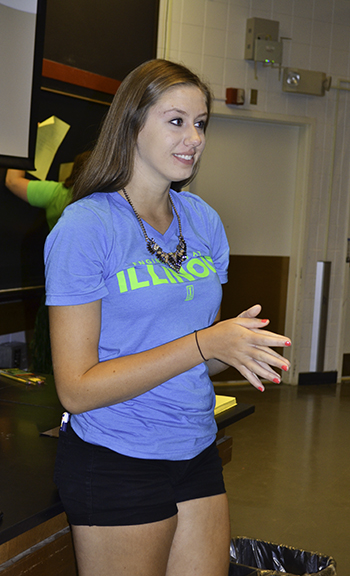
Student co-coordinator Lara Flasch
Student co-coordinator Lara Flasch gained the satisfaction of passing on to the next generation of engineering students what she’d received: “I feel like I just remember how I was when I was a freshman, and how much I appreciated the experience that my mentors gave me. I just really want to continue to be involved with that, so that I can make it better and better for the freshmen every year, and make sure they’re getting what they need and what’s going to prepare them for the College of Engineering.”
Those directly involved with the event weren’t the only ones who benefitted; one mother got peace of mind. According to WIE administrative assistant Robin McDaniel, the schedule the parents received conveyed: “’This is the experience that your daughter is getting coming to the orientation.’ One mom wrote back, ‘I’m so nervous about my daughter going to college, and this is my first child leaving, and I just really appreciate that you guys are doing this, and it makes me feel better having that kind of support for her.’ So those comments make it worth it,” says McDaniel.
What does Wolters get out of WIE Orientation? It makes her smile.
“I fully believe that this is one of the best programs that Women in Engineering does. I think that the benefits the students see, the connections WIE is able to make with the students during this time, the friendships that you see develop, you can’t help but smile and realize that those connections are an integral part of our students being successful, and so I love every minute of it.”
Will the mentoring/peer relationships built during WIE Orientation last? Although there’s no organized continuation of community building, according to Wolters, the Orientation is a kick-start to mentoring and relationships that continue on after Orientation is done, especially through Facebook.
“We do have a Facebook group, and everyone tends to communicate through their Facebook group, so that network continues. The freshmen will connect with their mentors on Facebook, and they’ll make subgroups, and share all the photos from orientation. We see it definitely continuing, but not in a structured way.”
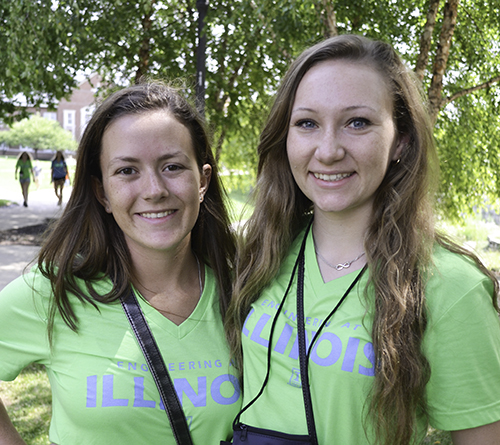
CEE freshmen Megan Fox and Dakota Gonzales.
What if its an emergency, and students don't have time to wait for a Facebook response? “All of our freshmen normally get their mentor’s phone numbers," says Wolters, "so they’re always a text away.”
Story and photos by Elizabeth Innes, Communications Specialist, I-STEM Education Initiative
More: Engineering, WIE, Women in STEM, 2015
For additional I-STEM articles about WIE Camp, see:
- WIE Camp 2014: Creating Community for Female Engineering Students
- Women in Engineering Camp Facilitates Relationship Building
- From WIE Camp to Seniors: Two Future Engineers Credit Illinois' Community of Support
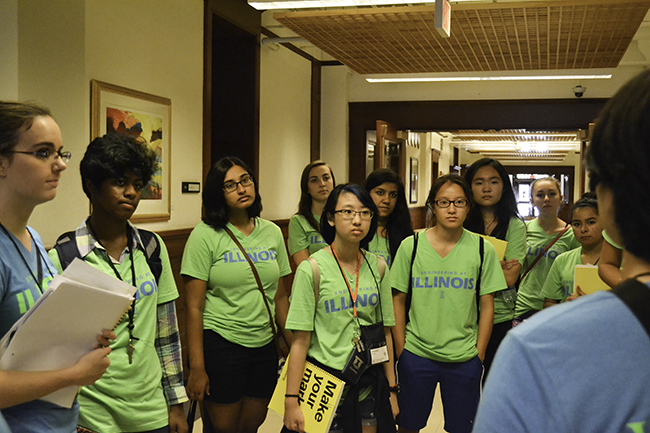
A mentor sharest important things they should know to WIE freshmen visiting the advising office in Engineering Hall during the scavenger hunt.
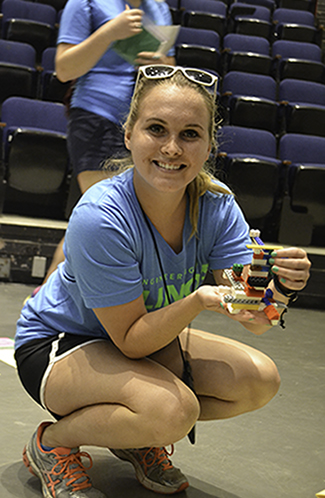
An engineering student turns in her team's completed Lego structure.
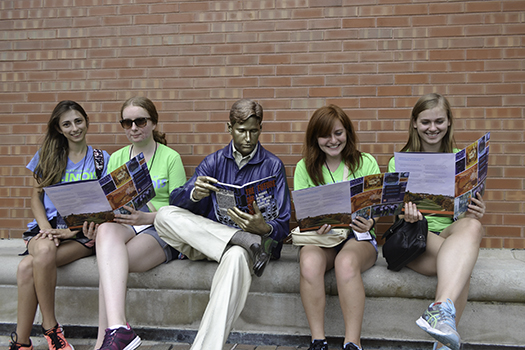
WIE freshmen and their mentor spend some time with Grainger Bob.
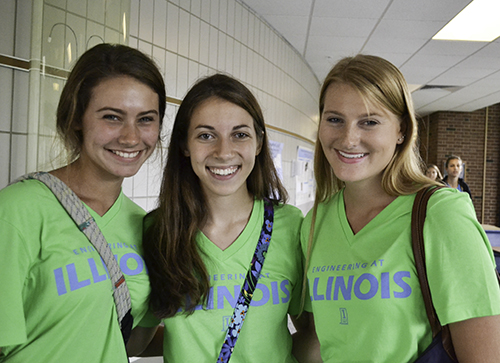
Three undeclared freshman engineering students who got acquainted during WIE Orientation and will most likely support each other during their time at Illinois.













.jpg)
















